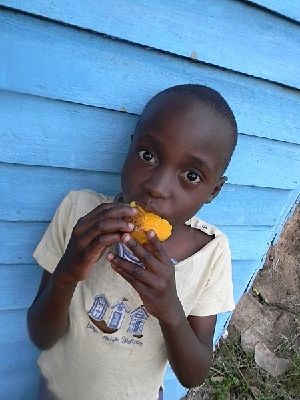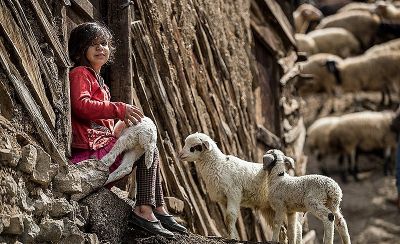Behavior
Behavior (American English) or behaviour (British English) is the range of actions and mannerisms in response to a given stimulus or situation. The response can be to a variety of stimuli or inputs, internal or external, conscious or subconscious, overt or covert, and voluntary or involuntary. In addition to living beings, human and other, the ways in which natural phenomena, artificial entities, and even machines function are included in behavior.
The primary focus of this article is human behavior, which includes and goes beyond the types of behavior observed in other species. Human beings behave in the most complex ways, from activities that satisfy biological needs to sustain physical life, through cognitive activities and reasoning, emotions, social and economic activities, to the most advanced moral and ethical choices that affect not only the individual but society as a whole. Finally, human behavior may also have a spiritual or religious component, based on faith in God and belief in an eternal afterlife, which guides the individual to behave based on internal rather than external values.
Introduction
Biology
Although disagreement exists as to how to precisely define behavior in a biological context, one common interpretation based on a meta-analysis of scientific literature states that "behavior is the internally coordinated responses (actions or inactions) of whole living organisms (individuals or groups) to internal and/or external stimuli."[1]
A broader definition of behavior, applicable to plants and other organisms, is similar to the concept of phenotypic plasticity. It describes behavior as a response to an event or environment change during the course of the lifetime of an individual, differing from other physiological or biochemical changes that occur more rapidly, and excluding changes that are result of development (ontogeny).[2]
Animals
The scientific and objective study of animal behavior, usually with a focus on behavior under natural conditions, is called ethology.[3] Ethology emerged as a discrete discipline in the 1920s, through the efforts of Konrad Lorenz, Karl von Frisch, and Niko Tinbergen, who were jointly awarded the 1973 Nobel Prize in Physiology or Medicine for their contributions to the study of behavior, specifically "their discoveries concerning organization and elicitation of individual and social behavior patterns."[4]
One of the key ideas of classical ethology is the concept of fixed action patterns (FAPs), stereotyped behaviors that occur in a predictable, inflexible sequence in response to an identifiable stimulus, known as the "releaser" or "sign stimulus."
For example, gull chicks peck at a red spot on their mother's beak to stimulate the regurgitating reflex. Also, at the sight of a displaced egg near the nest, the greylag goose will roll the egg back to the others with its beak. If the egg is removed, the animal continues to engage in egg-rolling behavior, pulling its head back as if an imaginary egg is still being maneuvered by the underside of its beak. It will also attempt to move other egg-shaped objects, such as a golf ball, doorknob, or even an egg too large to have been laid by the goose itself.[5]
Another important concept is imprinting, phase-sensitive learning (i.e., learning that occurs at a particular age or life stage) during which an animal learns the characteristics of some stimulus, which is therefore said to be "imprinted" onto the subject.
The best known form of imprinting is filial imprinting, in which a young animal learns the characteristics of its parent. Lorenz observed that the young of waterfowl such as geese spontaneously followed their mothers from almost the first day after they were hatched. Lorenz demonstrated how incubator-hatched geese would imprint on the first suitable moving stimulus they saw within what he called a critical period of about 36 hours shortly after hatching. Most famously, the goslings would imprint on Lorenz himself (more specifically, on his wading boots). Imprinting causes young animals to direct attention to the parent, keeping them close and thus safe while young, as well as providing a role model from which they can learn important survival skills.
In addition to instinctive or innate behaviors, animals are capable of varies degrees of learning. In other words, many animals change their behavior as the result of experience. While generally not as complex as human learning, animal learning is found across all species.
All animals engage in behaviors necessary for the maintenance and continuity of their species, by collecting food, building or finding shelter particularly for their young, and reproductive behaviors, either with a single, possibly lifelong, mate or with many partners. They also engage in social behaviors, primarily if not exclusively, with others of the same species. While some species remain solitary, or stay close to only their mate and offspring, many species form social groups, complete with hierarchies of dominant and submissive members.[6]
Humans
Like all living things, human beings live in ecosystems and interact with other organisms. Human behavior is affected by the environment in which a human lives, and environments are affected by human habitation. Humans have also developed man-made ecosystems such as urban areas and agricultural land. Geography and landscape ecology determine how humans are distributed within an ecosystem, both naturally and through planned urban morphology.[7]
Humans exercise control over the animals that live within their environment. Domesticated animals are trained and cared for by humans. Humans can develop social and emotional bonds with animals in their care. Pets are kept for companionship within human homes, including dogs and cats that have been bred for domestication over many centuries. Livestock animals, such as cattle, sheep, goats, and poultry, are kept on agricultural land to produce animal products. Domesticated animals are also kept in laboratories for animal testing. Non-domesticated animals are sometimes kept in nature reserves and zoos for tourism and conservation.
Human behavior
Human behavior is a complex interplay of three components: actions, cognition, and emotions.[8] Behavior is also driven, in part, by thoughts and feelings, which provide insight into individual attitudes and values. Human behavior is shaped by psychological traits, as personality types vary from person to person, producing different actions and behavior.
Human behavior is studied in the social sciences, which include psychology, sociology, ethology, and their various branches and schools of thought. The study of human behavior includes how the human mind evolved and how the nervous system controls behavior. The nature versus nurture debate considers how behavior is affected by genetic and environmental factors. Philosophy of mind considers aspects such as free will, the mind–body problem, and malleability of human behavior. The study of human behavior sometimes receives public attention due to its intersection with cultural issues, including crime, sexuality, and social inequality.[9]
Human behavior covers a wide spectrum: Physiological behavior accounts for actions to maintain the body. It is concerned with basic bodily functions as well as measures taken to maintain health. Cognitive behavior accounts for actions of obtaining and using knowledge. It is concerned with how information is learned and passed on, as well as creative application of knowledge and personal beliefs such as religion. Social behavior accounts for actions directed at others. It is concerned with the considerable influence of social interaction and culture, as well as ethics, interpersonal relationships, politics, and conflict. Economic behavior accounts for actions regarding the development, organization, and use of materials as well as other forms of work. Ecological behavior accounts for actions involving the ecosystem. It is concerned with how humans interact with other organisms and how the environment shapes human behavior.
Development
Human behavior is influenced by biological and cultural elements. An individual's personality and attitudes affect how behaviors are expressed.[10] Though genetic factors do not guarantee certain behaviors, certain traits can be inherited that make individuals more likely to engage in certain behaviors or express certain personalities.[11] While these specific traits of one's personality, temperament, and genetics lay the foundation for relatively consistent patterns of behavior, many behaviors change as one moves through the stages of life, from infancy through adolescence, adulthood, and into old age.

Infants are limited in their ability to interpret their surroundings shortly after birth. Infants are soon able to discern their own body from their surroundings and often take interest in their own limbs or actions they cause by two months of age. Infants practice imitation of other individuals to engage socially and learn new behaviors. In young infants, this involves imitating facial expressions, while imitation of tool use takes place within the first year. Object permanence and understanding of motion typically develop within the first six months of an infant's life, though the specific cognitive processes are not well understood. The ability to mentally categorize different concepts and objects that they perceive develops within the first year. Communication develops over the first year, and infants begin using gestures to communicate intention around nine to ten months of age. Verbal communication develops more gradually, taking form during the second year of age.[12]
Children develop fine motor skills in the range of three to six years of age, allowing them to engage in behaviors using the hands and eye–hand coordination and perform basic activities of self sufficiency. Children begin expressing more complex emotions in the three to six year old range, including humor, empathy, and altruism, as well engaging in creativity and inquiry. Aggressive behaviors also become varied at this age as children engage in increased physical aggression before learning to favor diplomacy over aggression. Children at this age can express themselves using language with basic grammar.[13]
Young children engage in basic social behaviors with peers, typically forming friendships with individuals of the same age and gender. Behaviors of young children are centered around play, which allows them to practice physical, cognitive, and social behaviors.[13] As children grow older, they develop emotional intelligence. Basic self-concept develops as children grow, particularly centered around factors such as gender, and behavior is heavily affected by peers for the first time.[14]
Adolescents undergo changes in behavior caused by puberty and the associated changes in hormone production. Production of testosterone increases sensation seeking and sensitivity to rewards as well as aggression and risk-taking in adolescent boys. Production of estradiol causes similar risk-taking behavior among adolescent girls. The new hormones cause changes in emotional processing that allow for close friendships, stronger motivations and intentions, and adolescent sexuality.[15] Adolescents undergo social changes on a large scale, developing a full self-concept and making autonomous decisions independently of adults. They typically become more aware of social norms and social cues than children, causing an increase in self-consciousness and egocentrism that guides behavior in social settings throughout adolescence.[16]
Physiological behavior

Humans behave in many ways that are similar to animals to support the processes of the human body, although often human behaviors are more complex and creative. Humans eat food to obtain nutrition. These foods may be chosen for their nutritional value, but they may also be eaten for pleasure, and particular food preparation processes are employed to make it more enjoyable.[17] Humans also regularly engage in sleep, based on homeostatic and circadian factors. The circadian rhythm causes humans to require sleep at a regular pattern and is typically calibrated to the day-night cycle and sleep-wake habits. Homeostasis is also be maintained, causing longer sleep longer after periods of sleep deprivation. The human sleep cycle takes place over 90 minutes, and it repeats 3-5 times during normal sleep.[18]
There are also unique behaviors that humans undergo to maintain physical health. Humans have developed medicine to prevent and treat diseases. In industrialized nations, eating habits that favor better nutrition, hygienic behaviors that promote sanitation, and medical treatment to eradicate diseases.[19] Humans engage in hygiene to limit exposure to dirt and pathogens. They can also engage in exercise to maintain health. Some of these behaviors are adaptive while others are learned. Basic behaviors of disgust evolved as an adaptation to prevent contact with sources of pathogens, resulting in a biological aversion to feces, body fluids, rotten food, and animals that are commonly disease vectors. Personal grooming, disposal of human corpses, use of sewerage, and use of cleaning agents are hygienic behaviors common to most human societies.[20]
The human hand is prehensile and capable of grasping objects and applying force with control over the hand's dexterity and grip strength. This allows the use of complex tools.
Humans reproduce sexually, engaging in sexual intercourse for both reproduction and sexual pleasure. Human reproduction is closely associated with human sexuality and an instinctive desire to procreate, though humans are unique in that they intentionally control the number of offspring that they produce.[21] How humans engage in reproductive behavior is heavily influenced by cultural norms and customs. For example, in the majority of societies throughout history some form of marriage, initiated through a wedding ceremony, is a prerequisite for beginning family life.
Cognitive behavior
Human cognition is distinct from that of other animals. This is derived from biological traits of human cognition, but also from shared knowledge and development passed down culturally. Humans are able to learn from one another by obtaining knowledge through education. The use of language allows humans to directly pass knowledge to one another. The human brain has neuroplasticity, allowing it to modify its features in response to new experiences. This facilitates learning in humans and leads to behaviors of practice, allowing the development of new skills in individual humans.[22]
Humans engage in reason to make inferences with a limited amount of information. Reasoning is carried out by making generalizations from past experiences and applying them to new circumstances. Learned knowledge is acquired to make more accurate inferences about the subject. Deductive reasoning infers conclusions that are true based on logical premises, while inductive reasoning infers what conclusions are likely to be true based on context.[23]
Emotion is a cognitive experience innate to humans. Basic emotions such as joy, distress, anger, fear, surprise, and disgust are common to all cultures, though social norms regarding the expression of emotion may vary. Other emotions come from higher cognition, such as love, guilt, shame, embarrassment, pride, envy, and jealousy. These emotions develop over time rather than instantly and are more strongly influenced by cultural factors. Emotions are influenced by sensory information, such as color and music, and moods of happiness and sadness. Humans typically maintain a standard level of happiness or sadness determined by health and social relationships, though positive and negative events have short-term influences on mood. Humans often seek to improve the moods of one another through consolation, entertainment, and venting. Humans can also self-regulate mood through exercise and meditation.[24]
Creativity is the use of previous ideas or resources to produce something original. It allows for innovation, adaptation to change, learning new information, and novel problem solving. Expression of creativity also supports quality of life. Creativity includes personal creativity, in which an individual presents new ideas, but it can also be expanded to social creativity, in which a community or society produces and recognizes ideas collectively.[25] Creativity is applied in typical human life to solve problems as they occur. It also leads humans to carry out art and science. Individuals engaging in advanced creative work typically have specialized knowledge in that field, and humans draw on this knowledge to develop novel ideas. In art, creativity is used to develop new artistic works, such as visual art or music. In science, those with knowledge in a particular scientific field can use trial and error to develop theories that more accurately explain phenomena.[26]
Religious behavior is a set of traditions that are followed based on the teachings of a religious belief system. The nature of religious behavior varies depending on the specific religious traditions. Most religious traditions involve variations of telling myths, studying scriptures, practicing rituals, making certain things taboo, adopting symbolism, determining morality, experiencing altered states of consciousness, and believing in supernatural beings or deities. Anthropologists offer competing theories as to why humans adopted religious behavior.[27] Religious behavior is heavily influenced by social factors, and group involvement is significant in the development of an individual's religious behavior. Social structures such as religious organizations or family units allow the sharing and coordination of religious behavior. These social connections reinforce the cognitive behaviors associated with religion, encouraging orthodoxy and commitment.[28]
Social behavior
Human social behavior is the behavior that involves relating with other humans, including communication and cooperation. It is highly complex and structured, as humans have developed society and culture distinct from other animals.[29] Human communication is based heavily on language, typically through speech or writing, although nonverbal communication and paralanguage can modify the meaning of communications by demonstrating ideas and intent through physical and vocal behaviors.[30]
Social norms
Human behavior in a society is governed by Social norms and enforced by social pressure. Social norms are unwritten expectations that members of society have for one another. These norms are ingrained in the particular culture that they emerge from, and affect every aspect of life, including decorum, social responsibility, property rights, contractual agreement, morality, justice, and meaning. Many norms facilitate coordination between members of society and prove mutually beneficial, such as norms regarding communication and agreements.
Systems of ethics are used to guide human behavior to determine what is moral. Ethical behavior takes into consideration how actions will affect others and whether behaviors will be optimal for others. What constitutes ethical behavior is determined by the individual value judgments of the person and the collective social norms regarding right and wrong. Value judgments are intrinsic to people of all cultures, though the specific systems used to evaluate them may vary. These systems may be derived from divine law, natural law, civil authority, reason, or a combination of these and other principles. Altruism is an associated behavior in which humans consider the welfare of others equally or preferentially to their own. While other animals engage in biological altruism, ethical altruism is unique to humans.[31]
Deviance is behavior that violates social norms, which vary between individuals and cultures. What is considered deviant by a society may also change over time as new social norms are developed. Deviance is punished by other individuals through social stigma, censure, or violence. Many deviant actions are recognized as Crimes and punished through a system of criminal justice. Deviant actions may be punished to prevent harm to others, to maintain a particular worldview and way of life, or to enforce principles of morality and decency.[32]
Interpersonal relationships
Interpersonal relationships are developed through communication, which creates intimacy, expresses emotions, and develops identity. An individual's interpersonal relationships form a social group in which individuals all communicate and socialize with one another, and these social groups are connected by additional relationships. Human social behavior is affected not only by individual relationships, but also by how behaviors in one relationship may affect others.[30] Individuals that actively seek out social interactions are generally considered extraverts, and those that do not as introverts.[33]
Romantic love is a significant interpersonal attraction toward another. Its nature varies by culture, but it is often contingent on gender, occurring in conjunction with sexual attraction. It takes different forms and is associated with many individual emotions. Many cultures place a higher emphasis on romantic love than other forms of interpersonal attraction. Marriage is a union between two people, though whether it is associated with romantic love is dependent on the culture. Individuals that are closely related by consanguinity form a family. There are many variations on family structures that may include parents and children as well as stepchildren or extended relatives.[30] Family units with children emphasize parenting, in which parents engage in a high level of parental investment to protect and instruct children as they develop over a period of time longer than that of most other mammals.[34]
Groups and conflict
Individuals will often form in-group and out-group perceptions, through which individuals cooperate with the in-group and compete with the out-group. When humans oppose one another, it creates conflict. It may occur when the involved parties have a disagreement of opinion, when one party obstructs the goals of another, or when parties experience negative emotions such as anger toward one another. Conflicts purely of disagreement are often resolved through communication or negotiation, but incorporation of emotional or obstructive aspects can escalate conflict. Humans also engage in behaviors that facilitate cooperation rather than conflict in collective settings.
Interpersonal conflict is that between specific individuals or groups of individuals. Social conflict is that between different social groups or demographics. This form of conflict often takes place when groups in society are marginalized, do not have the resources they desire, wish to instigate social change, or wish to resist social change. Significant social conflict can cause civil disorder.[35] International conflict is that between nations or governments. It may be solved through diplomacy or war.
Economic behavior
Advanced economic behavior developed in humans after the Neolithic Revolution and the development of agriculture. These developments led to a sustainable supply of resources that allowed specialization in more complex societies.[36]
Humans engage in predictable behaviors when considering economic decisions, and these behaviors may or may not be rational. Human economic decision making is often reference dependent, in which options are weighed in reference to the status quo rather than absolute gains and losses. Basic decisions are made through cost–benefit analysis and the risk–return spectrum. Humans are loss averse, fearing loss rather than seeking gain.
Work
The nature of human work is defined by the complexity of society. The simplest societies are tribes that work primarily for sustenance as hunter-gatherers. In this sense, work is not a distinct activity but a constant that makes up all parts of life, as all members of the society must work consistently to stay alive. More advanced societies developed after the Neolithic Revolution, emphasizing work in agricultural and pastoral settings. In these societies, production is increased, ending the need for constant work and allowing some individuals to specialize and work in areas outside of food-production. This also created non-laborious work, as increasing occupational complexity required some individuals to specialize in technical knowledge and administration. The nature of work changed significantly during the Industrial Revolution in which the factory system was developed. Further changes occur in post-industrial societies where technological advance makes industries obsolete, replacing them with mass production and service industries.[36]
Humans approach work differently based on both physical and personal attributes, and some work with more effectiveness and commitment than others. Some find work to contribute to personal fulfillment, while others work only out of necessity. Work can also serve as an identity, with individuals identifying themselves based on their occupation. Work motivation is complex, both contributing to and subtracting from various human needs. Although the primary motivation for work is often for material gain, which takes the form of money in modern societies, work may also serve to create self-esteem and personal worth, provide activity, gain respect, and express creativity.[36]
Consumption
Humans operate as consumers that obtain and use goods. All production is ultimately designed for consumption, and consumers adapt their behavior based on the availability of production. Mass consumption began during the Industrial Revolution, caused by the development of new technologies that allowed for increased production.[37] Many factors affect a consumer's decision to purchase goods through trade. They may consider the nature of the product, its associated cost, the convenience of purchase, and the nature of advertising around the product. Cultural factors may influence this decision, including a consumer's interpersonal relationships and reference groups.
Leisure

Leisure is activity or lack of activity that takes place outside of work. It provides relaxation, entertainment, and improved quality of life for individuals. Casual leisure behaviors provide short-term gratification, but they do not provide long-term gratification or personal identity. These include play, relaxation, casual social interaction, volunteering, passive entertainment, and active entertainment. Passive entertainment is typically derived from mass media, which may include written works or digital media. Active entertainment involves games in which individuals participate. Serious leisure behaviors involve non-professional pursuit of arts and sciences, the development of hobbies, or career volunteering in an area of expertise.
Leisure can be beneficial for physical and mental health. It may be used to seek temporary relief from psychological stress, to produce positive emotions, or to facilitate social interaction. [38]
Notes
- ↑ Daniel A. Levitis, William Z. Lidicker, Jr, and Glenn Freund, Behavioural biologists do not agree on what constitutes behaviour Animal Behaviour 78 (2009): 103–110. Retrieved March 18, 2023.
- ↑ Richard Karban, Plant Sensing and Communication (University of Chicago Press, 2015, ISBN 978-0226264707).
- ↑ ethology Merriam-Webster Dictionary. Retrieved March 18, 2023..
- ↑ The Nobel Prize in Physiology or Medicine 1973 The Nobel Prize. Retrieved March 18, 2023.
- ↑ Niko Tinbergen, The Study of Instinct (New York: Oxford University Press, 1991, ISBN 0198577222).
- ↑ Lee Alan Dugatkin, Principles of Animal Behavior (University of Chicago Press, 2020, ISBN 978-0226448381).
- ↑ Brian D. Fath (ed.), Encyclopedia of Ecology (Elsevier, 2019, ISBN 0444637680).
- ↑ Bryn Farnsworth, Human Behavior Research: The Complete Guide Imotions, July 28, 2022. Retrieved March 18, 2023.
- ↑ Helen E. Longino, Studying Human Behavior: How Scientists Investigate Aggression and Sexuality (University of Chicago Press, 2013, ISBN 978-0226492889).
- ↑ Stephen P. Hinshaw and Theodore P. Beauchaine (eds.), Child and Adolescent Psychopathology (Wiley, 2017, ISBN 978-1119169956).
- ↑ Valerie S. Knopik, Jenae M. Neiderhiser, John C. DeFries, and Robert Plomin, Behavioral Genetics (Worth Publishers, 2016, ISBN 978-1464176050).
- ↑ Gavin Bremner and Theodore D. Wachs (eds.), The Wiley-Blackwell Handbook of Infant Development. Vol. 1: Basic Research (Wiley-Blackwell, 2010, ISBN 978-1444332735).
- ↑ 13.0 13.1 Debra J. Woody and David Woody, "Early Childhood" in Elizabeth D. Hutchison, (ed.), Dimensions of Human Behavior: The Changing Life Course 6th Edition (SAGE Publications, Inc, 2018, ISBN 978-1544339344), 251–326.
- ↑ Leanne Wood Charlesworth, "Early Childhood" In Elizabeth D. Hutchison, (ed.), Dimensions of Human Behavior: The Changing Life Course 6th Edition (SAGE Publications, Inc, 2018, ISBN 978-1544339344), 327–395.
- ↑ Jiska S. Peper and Ronald E. Dahl, The Teenage Brain: Surging Hormones—Brain-Behavior Interactions During Puberty, Current Directions in Psychological Science 22(2) (2013):134–139.
- ↑ Suparna Choudhury, Sarah-Jayne Blakemore, and Tony Charman, Social cognitive development during adolescence Social Cognitive and Affective Neuroscience 1(3) (December 2006): 165–174. Retrieved March 19, 2023.
- ↑ Jim Mann and Stewart Truswell, Essentials of Human Nutrition (Oxford University Press, 2012, ISBN 978-0199566341).
- ↑ Brain Basics: Understanding Sleep National Institute of Health. Retrieved March 19, 2023.
- ↑ Thomas McKeown, The Role of Medicine (Princeton University Press, 2014, ISBN 978-0691616360).
- ↑ Valerie A. Curtis, A Natural History of Hygiene, Canadian Journal of Infectious Diseases and Medical Microbiology 18(1) (2007): 11–14.
- ↑ L.M. Baggott, Human Reproduction (Cambridge University Press, 1997, ISBN 978-0521469142).
- ↑ Thomas A. Farmer and Margaret W. Matlin, Cognition (Wiley, 2019, ISBN 978-1119491712).
- ↑ Stephen E. Newstead, Ruth M.J. Byrne, and Jonathan St.B.T. Evans, Human Reasoning: The Psychology of Deduction (Psychology Press, 1993, ISBN 978-0863773143).
- ↑ Dylan Evans, Emotion: A Very Short Introduction (Oxford University Press, 2019, ISBN 978-0198834403).
- ↑ Robert J. Sternberg and James C. Kaufman (eds.), The Nature of Human Creativity (Cambridge University Press, 2018, ISBN 978-1107199811)
- ↑ Herbert A. Simon, Creativity in the Arts and the Sciences The Kenyon Review 23(2) (2001): 203–220. Retrieved March 20, 2023.
- ↑ Richard Sosis and Candace Alcorta, Signaling, solidarity, and the sacred: The evolution of religious behavior Evolutionary Anthropology: Issues, News, and Reviews 12(6) (November 2003):264–274. Retrieved March 20, 2023.
- ↑ Marie Cornwall, The Determinants of Religious Behavior: A Theoretical Model and Empirical Test Social Forces 68(2) (1989): 572–592. Retrieved March 20, 2023.
- ↑ Stephen C. Levinson and Nicholas J. Enfield (eds.), Roots of Human Sociality: Culture, Cognition and Interaction (Routledge, 2006, ISBN 978-1845203948).
- ↑ 30.0 30.1 30.2 Steve Duck, Human Relationships (SAGE Publications, 2007, ISBN 978-1412929998).
- ↑ Francisco J. Ayala, The difference of being human: Morality Proceedings of the National Academy of Sciences 107 (supplement 2) (May 5, 2010):9015–9022. Retrieved March 20, 2023.
- ↑ Erich Goode, The Handbook of Deviance (Wiley-Blackwell, 2015, ISBN 978-1118701423).
- ↑ Michael Argyle and Luo Lu, The happiness of extraverts Personality and Individual Differences 11(10) (1990): 1011–1017. Retrieved March 20, 2023..
- ↑ David C. Geary and Mark V. Flinn, Evolution of Human Parental Behavior and the Human Family Parenting 1(1–2) (2011):5–61. Retrieved March 20, 2023.
- ↑ Christopher R. Mitchell, Conflict, Change and Conflict Resolution Berghof Handbook for Conflict Transformation Retrieved March 20, 2023.
- ↑ 36.0 36.1 36.2 Walter S. Neff, Work and Human Behavior (Routledge, 2006, ISBN 978-0202309095).
- ↑ Jan de Vries, The Industrious Revolution: Consumer Behavior and the Household Economy, 1650 to the Present (Cambridge University Press, 2008, ISBN 978-0521719254).
- ↑ Linda L. Caldwell, Leisure and health: why is leisure therapeutic? British Journal of Guidance & Counselling 33(1) (2005):7–26. Retrieved March 20, 2023.
ReferencesISBN links support NWE through referral fees
- Baggott, L.M. Human Reproduction. Cambridge University Press, 1997. ISBN 978-0521469142
- Bremner, Gavin, and Theodore D. Wachs (eds.). The Wiley-Blackwell Handbook of Infant Development. Vol. 1: Basic Research. Wiley-Blackwell, 2010. ISBN 978-1444332735
- de Vries, Jan. The Industrious Revolution: Consumer Behavior and the Household Economy, 1650 to the Present. Cambridge University Press, 2008. ISBN 978-0521719254
- Duck, Steve. Human Relationships. SAGE Publications, 2007,. ISBN 978-1412929998
- Dugatkin, Lee Alan. Principles of Animal Behavior. University of Chicago Press, 2020. ISBN 978-0226448381
- Evans, Dylan. Emotion: A Very Short Introduction. Oxford University Press, 2019. ISBN 978-0198834403
- Farmer, Thomas A., and Margaret W. Matlin. Cognition. Wiley, 2019. ISBN 978-1119491712
- Fath, Brian D. (ed.). Encyclopedia of Ecology. Elsevier, 2019. ISBN 0444637680
- Goode, Erich. The Handbook of Deviance. Wiley-Blackwell, 2015. ISBN 978-1118701423
- Hinshaw, Stephen P., and Theodore P. Beauchaine (eds.). Child and Adolescent Psychopathology. Wiley, 2017. ISBN 978-1119169956
- Hutchison, Elizabeth D. (ed.). Dimensions of Human Behavior: The Changing Life Course 6th Edition. SAGE Publications, Inc, 2018. ISBN 978-1544339344
- Karban, Richard. Plant Sensing and Communication. University of Chicago Press, 2015. ISBN 978-0226264707
- Knopik, Valerie S., Jenae M. Neiderhiser, John C. DeFries, and Robert Plomin. Behavioral Genetics. Worth Publishers, 2016. ISBN 978-1464176050
- Levinson, Stephen C., and Nicholas J. Enfield (eds.). Roots of Human Sociality: Culture, Cognition and Interaction. Routledge, 2006. ISBN 978-1845203948
- Longino, Helen E. Studying Human Behavior: How Scientists Investigate Aggression and Sexuality. University of Chicago Press, 2013. ISBN 978-0226492889
- Mann, Jim, and Stewart Truswell. Essentials of Human Nutrition. Oxford University Press, 2012. ISBN 978-0199566341
- McKeown, Thomas. The Role of Medicine. Princeton University Press, 2014. ISBN 978-0691616360
- Neff, Walter S. Work and Human Behavior. Routledge, 2006. ISBN 978-0202309095
- Newstead, Stephen E., Ruth M.J. Byrne, and Jonathan St.B.T. Evans. Human Reasoning: The Psychology of Deduction. Psychology Press, 1993. ISBN 978-0863773143
- Sternberg, Robert J., and James C. Kaufman (eds.). The Nature of Human Creativity. Cambridge University Press, 2018. ISBN 978-1107199811
- Tinbergen, Niko. The Study of Instinct. New York: Oxford University Press, 1991. ISBN 0198577222
External links
All links retrieved March 20, 2023.
- What is behavior? Baby don't ask me, don't ask me, no more by Piter Kehoma Boll at Earthling Nature.
Credits
New World Encyclopedia writers and editors rewrote and completed the Wikipedia article in accordance with New World Encyclopedia standards. This article abides by terms of the Creative Commons CC-by-sa 3.0 License (CC-by-sa), which may be used and disseminated with proper attribution. Credit is due under the terms of this license that can reference both the New World Encyclopedia contributors and the selfless volunteer contributors of the Wikimedia Foundation. To cite this article click here for a list of acceptable citing formats.The history of earlier contributions by wikipedians is accessible to researchers here:
The history of this article since it was imported to New World Encyclopedia:
Note: Some restrictions may apply to use of individual images which are separately licensed.








